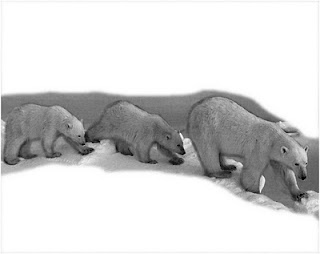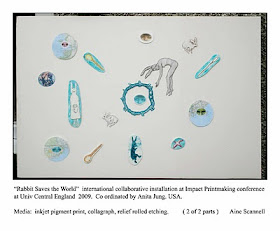Anyway I have a love of bears as I know, many many people do, I didn't have a teddy bear when I was a kid but my brother B. did and he was part of our family of toy beings. I had my two dolls "Miranda" and "Delores" and B. had "Teddy" yep that was his name. He was quite a thread worn bear and we were all fond of him.
Myself and B. were horrified one day, when we heard mother had given him to the neighbours younger children. It wasn’t that we still played with him or anything but that he was a kind of family heirloom.
Anyway enough of our childhood traumas………so with this love of bears - I have invariably been collecting photos as and when I encounter them over the years.
So I decided I would make a print with bears in it and had this particular favorite photo which showed three bears going across the snow; the two cubs following their mother.
 Here's the original image, desaturated to black and white and with the essential elements of what I liked about the image - i.e., that they were kind of walking through a tunnel, which is representative of their long journey to the sea, yet it is one that goes on year after year.
Here's the original image, desaturated to black and white and with the essential elements of what I liked about the image - i.e., that they were kind of walking through a tunnel, which is representative of their long journey to the sea, yet it is one that goes on year after year.I had to spend almost one week going backwards and forwards to the image trying to introduce more tone to this black and white image so that when I converted it into a “bitmap” image, the dots would have sufficient variation to translate to the resist on the plate before it went into the mordant.
Lately a few members of FDPW have asked me about
Converting an image for acetate print out , for photo etch on the light box.
So here’s what you do:
So here’s what you do:
Before you do anything at all I would advise you make a copy of your image on your computer.
Prior to putting your image though the conversion process (to Bitmap) be sure and use the brightness/contrast option under IMAGE at the top options bars which you drop down to ADJUST and then across to brightness/contrast.
In addition to this, which does everything all at once, all over,
You can also use the DODGE tool…….the icon for this looks like a little black lollipop
And
the BURN tool …….the icon for this looks like a hand
These tools are located in the seventh box down in the toolbox on the right hand side..
First choose the type of mark making device you want to use. If you have never done this before and in a way for the most straightforward tool choose the number 2 pencil which is in the “dry media” list of tools.
Just along from the little icon which shows the tool you have chosen to use i.e., burn tool
Choose now the size of head you want i.e., for fine detail you may want 2 to 5 depending on your image size or pull the marker along the bar for a larger head eg 30.
Remember if you do any action in Photosop whilst editing your image to get the tones right then don’t worry because you can go up to the options menus at the top of the screen and choose “edit” and then the first option from the drop down menu, which with the emphasis on darkening areas of your image. is “undo “ so if you do something you are not happy with then you can go a step back.
Shadows :
if you rub your tool over a dark area with your burn tool it will completely lighten that dark area (that’s with the exposure set at 100 % I usually have it set quite low at eg under 20 % But of course it depends on the image.
Midtones If you put the dodge tool on this it will totally brighten such an area. But again that’s with the exposure set at 100%
Highlights
If you put the dodge tool on this it will totally brighten such an area. But again that’s with the exposure set at 100%
The Burn tool works in a similar way But with the emphasis on darkening the areas of your image.
“Preparation of positives for photoetch”
When your image is ready for printing out onto your acetate Here's what you do.
1
Have your image at a resolution of 200 dpi
2
Converted to black and white using the IMAGE bar at the top of the Photoshop drop down options go down to adjust and then across to DESATURATEwhich makes the image black and white.
3
Then go to IMAGE …………..MODE
Chose…………….GREYSCALE.
4
then chose Image …..MODE….BITMAP
as part of that process a dialog box will come up and inside of that
for METHOD choose dither ( which gives a more random dot / speckly quality to the image) for photo etching
for OUTPUT choose 200 dpi – this is what I have found works best for me.
That’s it
Essentially what you need to remember is that, the denser the dots the darker the tone.
You can buy OHP Transparencies inkjet film, from WH Smith. I got a pack (60 sheets) A4, which cost £19.99 and it has lasted me for absolutely ages –it still is about half full.
One more thing if your inkjet transparency that you print out doesn’t seem black enough – print another one and then line them up and tape them together which will help with blocking the UV light for your photo etch.

















